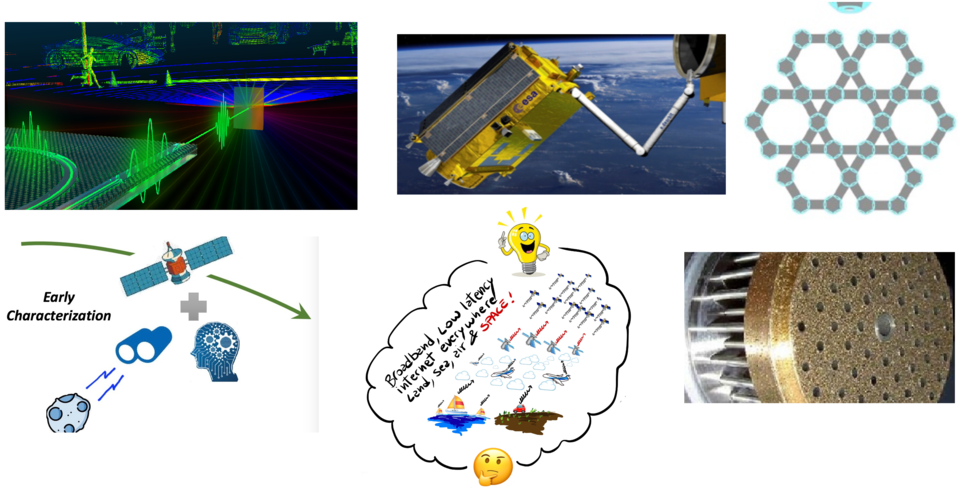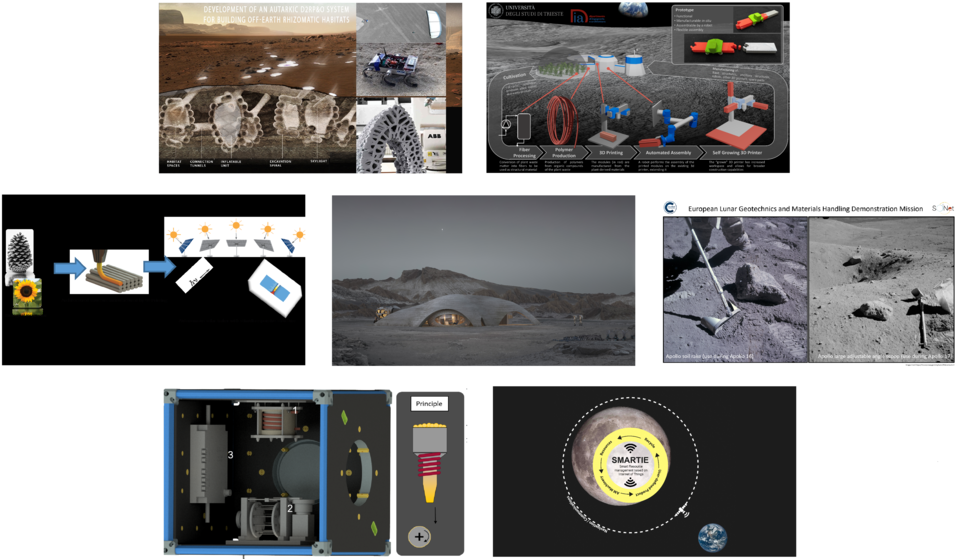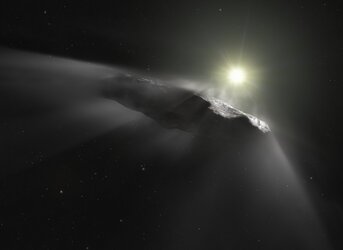Implemented OSIP ideas — December 2020
ESA's Open Space Innovation Platform (OSIP) seeks novel ideas for new space research activities. Campaigns and Channels invite solutions to specific problems or ideas on more general topics, with those run by Discovery & Preparation, including the Open Discovery Ideas Channel, specifically looking for ideas that could be implemented as system studies, early technology developments, or PhD or postdoc research co-funded by ESA and a university.
Open Discovery Ideas Channel

In December 2020, the following ideas were implemented through the Open Discovery Ideas Channel.
--------------------------------------------------
Experimental investigation of injection technologies for deep throttling lander rocket engines
University of Stuttgart / Institute of Space Systems
Spacecraft landing on the Moon or Mars require drastically varying levels of thrust as they descend and land onto the surface of these bodies. In the past, this variation has been achieved using a large number of clustered engines combined with a complex propulsion system. This research – co-funded by ESA and the University of Stuttgart – aims to develop a flexible system that can efficiently provide throttling down to 10% of the nominal thrust level.
--------------------------------------------------
Guidance and control of autonomous in-orbit operation based on embedded real-time optimisation
ETH Zurich
Future space missions will need to be increasingly independent. In particular, ESA is starting to develop in-orbit servicing missions that will refuel, service, assemble or capture existing satellites. The safety and success of these servicing missions requires us to update our planning, guidance and control methods to make the missions more autonomous. This research project – co-funded by ESA and ETH Zurich – will investigate how to increase the autonomy level of in-orbit operation missions.
--------------------------------------------------
Use of mega-constellation services in space
Institut Supérieur de l’Aéronautique et de l’Espace
Mega-constellations of satellites are becoming a popular solution for global telecommunications coverage. They transmit and receive radio frequency signals to and from Earth. Thousands of spacecraft currently operate between these mega-constellations and the ground, i.e. in the region through which the radio signals pass. The idea behind this co-sponsored research is to study the feasibility and impact of using the same internet provided by mega-constellations for these satellites in low Earth orbit.
--------------------------------------------------
Photonic integrated coherent LiDAR engine
École Polytechnique Fédérale de Lausanne
Read about this public idea in OSIP
--------------------------------------------------
Artificial intelligence-assisted optical navigation for early characterisation phase of small body missions
University of Strathclyde
As it approaches a small body, for example an asteroid, a spacecraft must estimate the body's motion and physical properties; this is known as the early characterisation phase. During this phase, the spacecraft is navigated by Earth-based operators. This co-funded research will investigate how artificial intelligence can be applied to the early characterisation phase to improve the Earth-based navigation performance, as well as how the trajectory of a spacecraft can be optimised to improve the efficiency of this phase.
--------------------------------------------------
Off-Earth Manufacturing and Construction

The following ideas were implemented through the OSIP Off-Earth Manufacturing and Construction Campaign.
--------------------------------------------------
Rhizome: development of an autarkic design-to-robotic-production and -operation system for building off-Earth habitats
Technische Universiteit Delft
Rather than building shelter on the Moon's surface, this research study will investigate creating a habitat underground. Not only will this achieve natural protection from radiation, it will also provide thermal insulation. At the same time, through excavation of the ground, valuable resources can be mined. The study will develop a swarm of mobile robots to excavate the ground in a downward spiral movement. The excavated material will be mixed with liquid sulphur to create concrete, which can be 3D printed to create a structure in the excavated tunnels.
--------------------------------------------------
Fused Layer Deposition (FLM) of lunar regolith
Aalen University
In the past, various additive manufacturing (3D printing) techniques have been tested to create materials to use on the Moon, including solar and laser sintering. However, cracks often formed in the resulting materials, meaning that their mechanical properties are not adequate. This study will investigate a new method of additive manufacturing called Fused Layer Deposition, in which lunar regolith is melted in a controlled manner and used to build up new materials that would be more resistant to cracking.
--------------------------------------------------
Off-Earth manufacturing through self-growing 3D printer
University of Trieste
Plants are the factories of nature, transforming minerals and water into functional organic matter, such as fibres and cellulose. Such a process could be exploited on the lunar surface for construction using organic material. This research study aims to use vegetable fibres to produce complex and scalable production systems. Starting from a precursor lunar mission equipped with a small 3D printer, it would be possible to fabricate modules that can be assembled on the 3D printer itself by a robot. This process allows for the 3D printer to 'grow' in size, using only plant matter grown in-situ as the printed material.
--------------------------------------------------
Definition of a European lunar materials handling and geotechnics payload
Cranfield University
Read about this public idea in OSIP
--------------------------------------------------
Biologically inspired autonomous solar tracker made with 4D printed shape-changing metamaterials
University of Southern Brittany
Solar trackers adapt the inclination of a solar panel over the course of a day to keep it pointing towards the Sun. Although this may lead to a more effective solar panel, it costs energy and requires maintenance, which makes it difficult to use solar trackers in a space environment. This co-funded research will investigate the development of an autonomous solar tracker inspired by biology – in particular sunflowers – that can be made with materials that respond to stimuli such as temperature and radiation. These materials could be manufactured through 4D printing.
--------------------------------------------------
Design of a scalable framework of lunar habitats
HASSELL Studio, Cranfield University
This study will investigate a scalable lunar habitat framework, driven through a holistic and mission architecture approach. The framework will build upon and link with existing space habitation programmes such as the Lunar Gateway. A major requirement of the design is its scalability, catering for potential expansion of lunar infrastructure and prolonged human settlement, i.e. a Moon Village.
--------------------------------------------------
SMARTIE: Smart resource management based on Internet of things to support off-Earth manufacturing of lunar infrastructures
Liquifer Systems Group
This study will look into developing off-Earth manufacturing architecture based on a combination of 3D printing and the Internet of things (IoT). The team behind the study hopes that this will provide the smart and efficient management of available resources for long-term survival of both crew and technological assets in harsh space environments.
--------------------------------------------------
Model-Based System Engineering (MBSE)

The following ideas were implemented through the OSIP Model-Based System Engineering Campaign.
--------------------------------------------------
EasyMod or how to facilitate the acceptability of MBSE to systems engineers
Institute of Technology Saint Exupéry
Despite its proven modelling value in many engineering domains, Computer-aided design (CAD) tools are only moderately accepted by system engineers and architects to assist them in their day-to-day tasks. The complexity of creating, editing and annotating models of system engineering takes its root from different sources: unsuitable representations, outdated interfaces, laborious modification, and difficult collaboration. This early technology development activity aims to facilitate the acceptance of MBSE amongst system engineers.
--------------------------------------------------
Enabling continuity: from design to operations
VisionSpace Technologies
MBSE is already common across the space industry, supporting the design, assembly, integration and testing of space systems. But the reliance on MBSE typically ends once a system leaves the supplier. Once the system is delivered to the client/operator, all the information and knowledge encoded in the models are usually written down in text-based documents. There is a clear digital divide between the design team and the operations team. The objective of this early technology development activity is to understand how to best bridge this divide then implement a proof of concept.
--------------------------------------------------
Validating SEDS as a bridge between hardware and software models
N7 Space
An Electronic Data Sheet (EDS) is a machine-readable mechanism to describe the interfaces between electronic units on board spacecraft. A new EDS standard for the space industry was introduced in 2019 called CCSDS SEDS. This early technology development activity will validate the applicability of the new EDS standard as a bridge between hardware definitions and software models.
--------------------------------------------------
Space to ground interface control model
VisionSpace Technologies
Space to Ground Interface Control Documents (S2GICD) define the data interfaces between satellites and their instruments and the ground segment, including ground stations, the Flight Operation Segment and the Payload Ground Segment. The goal of this early technology development project is to develop a proof-of-concept tool that can use a model-based S2GICD to generate both the human-readable (Word) version of the interface control document and configuration of the mission control system.
--------------------------------------------------
Science AOCS/GNC with SysML
SENER
This research study aims to digitalise Attitude Orbit and Control Systems / Guidance, Navigation and Control processes to remove the need for very detailed documentation and difficult-to-follow texts by enabling the end user to easily follow and operate a subsystem based on diagrams. The diagrams would be created in SysML, a graphical modelling language with enormous potential as a descriptive language.
--------------------------------------------------
Artificial intelligence (AI) and natural language processing (NLP) to support space engineering activities
Thales Alenia Space
Replacing traditional text-based approaches, model-based approaches have proved that they can efficiently support engineering activities. However, in many cases, engineering artifacts are text-based either because the return-on-investment of introducing models is too low or because the information is more efficiently expressed in natural language – even if inconsistencies and inaccuracies appear. Huge progress has been made recently in artificial intelligence-based natural language processing. This early technology development activity involves spinning in these advancements into space engineering processes, studying how natural language processing can help space engineers in their daily activities.
--------------------------------------------------
Systematic search of optimal space system missions design using set-based concurrent engineering based on models
Thales Alenia Space
Traditionally, new space systems are designed using point-based approaches; the design team focuses on one or a few designs defined very early in the process and enhances them until they fulfill the user's needs. This does not necessarily lead to an optimal solution. On the other hand, set-based concurrent engineering promotes finding an optimal set of solutions by being open-minded – starting from the complete design space and gradually narrowing parameters down as the team gains knowledge of the solution. This study will develop models to support this set-based concurrent engineering approach.
--------------------------------------------------
Early in the loop MBSE assessment of electronic availability for nano/micro satellite mission
Institute of Technology Saint Exupéry
Read about this public idea in OSIP
--------------------------------------------------
TeePee4Space – perform structural analyses on an heterogeneous and distributed set of models
Institute of Technology Saint Exupéry
Read about this public idea in OSIP
--------------------------------------------------
MBSE enhanced by semantic data lakes integration and machine learning
ScopeSET Technology Deutschland
Model-based systems engineering is only as powerful as the data it works from. A 'data lake' is a system or repository of data that can become a messy 'data swamp' if there is no descriptive metadata and a mechanism to use the data. This early technology development project aims to make engineering data stores more useful by applying the following features to a big data engineering platform: creating a high-performing data lake, applying a semantic layer on top of the 'raw data', enabling 'Google-like' searches on the data, and applying scalable semantic analytics stack and machine learning approaches.
--------------------------------------------------
FAMOUS improvement: transfer of academic knowledge to semantic interoperability
GorillaIT
Read about this public idea in OSIP
--------------------------------------------------
Model-based avionics
Thales Alenia Space
Read about this public idea in OSIP
--------------------------------------------------
End-to-end space systems engineering portal
SpaceCube UG
ESA has been investing in MBSE research for many years, developing various solutions to different problems. Building upon these solutions, as well as other capabilities and tools, this early technology development project aims to develop an end-to-end space systems engineering portal. The portal will offer a web-based environment where users can explore and transition models between different engineering phases and formats. The enabled data continuity will lead to reducing the time, risks and costs for the overall space systems engineering activities.
--------------------------------------------------
Integration of the COMPASS and TASTE toolsets
Fondazione Bruno Kessler
Read about this public idea in OSIP
--------------------------------------------------
Harmonising MBSE standards into ECSS
CGI Deutschland
The European Cooperation for Space Standardisation, is an organisation that works to improve standardisation within the European space sector. The ECSS frequently publishes standards, to which contractors working for ESA must adhere. The goal of this study is to identify a way to harmonise different MBSE approaches such that an ECSS standard can be derived, using model-based documentation as the main transportation medium.
--------------------------------------------------
Remote Sensing of Plastic Marine Litter
The following idea was implemented through the OSIP Remote Sensing of Plastic Marine Litter Campaign.
--------------------------------------------------
Multi-model synthetic S2-HS (hyperspectral) data for marine/plastic debris characterisation
Vrije Universiteit Brussel
Research suggests that short-wave infrared light is most useful for detecting plastic debris larger than 300 micrometres across. So ideally, we would like hyperspectral data at short-wave infrared (1000–2500 nm) at a resolution of one pixel for every half metre on the ground. But these characteristics are non-existent in current Earth observation missions, and will still be difficult to find in future missions. This research study aims to use novel spectral and spatial enhancement methods to generate simulated short-wave infrared data from the Copernicus Sentinel-2 satellite using spectral response function modeling.
--------------------------------------------------















 Germany
Germany
 Austria
Austria
 Belgium
Belgium
 Denmark
Denmark
 Spain
Spain
 Estonia
Estonia
 Finland
Finland
 France
France
 Greece
Greece
 Hungary
Hungary
 Ireland
Ireland
 Italy
Italy
 Luxembourg
Luxembourg
 Norway
Norway
 The Netherlands
The Netherlands
 Poland
Poland
 Portugal
Portugal
 Czechia
Czechia
 Romania
Romania
 United Kingdom
United Kingdom
 Slovenia
Slovenia
 Sweden
Sweden
 Switzerland
Switzerland
























